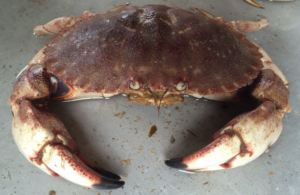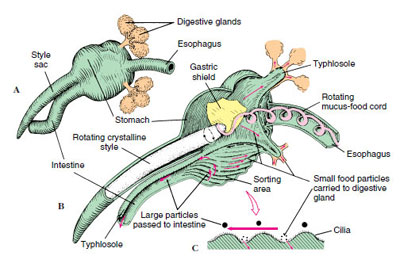
Barnegat Bay is home to several species of crabs, but the Blue crab is the most common and sought after.
Crabs Crustaceans
Rock Crabs and Jonah Crabs
Atlantic Rock Crab Cancer irroratus Walking crab
 Rock crabs live in the benthic zone (bottom) of the ocean and bay. They are able to adapt to extreme variations in depth.
Rock crabs live in the benthic zone (bottom) of the ocean and bay. They are able to adapt to extreme variations in depth.
The depths that they exist at range from deep waters at 2,600ft. to very shallow waters and occasionally well inland from the low tide line.
They live on a variety of substrate types including rocky and loose material.
Smaller crabs with the cephalorthorax width of about 2 inches (50 mm) tend to inhabit muddy or sandy bottoms, while other crabs seem to prefer the rocky bottoms
The rock crab varies in color from red-orange to yellowish-green
An interesting thing regarding Cancer irroratus food habits is their responsiveness and affinity to food types they were already accustomed to rather than to ones with which they were unfamiliar.
Rock crabs are extremely mobile and do not remain in one spot for too long.
They are opportunistic feeders.
They inhabit the benthic zone from deep or shallow waters so their food source is limited to species that can survive in this zone as well.
They eat an assortment of items including algae, worms, mussels, gastropods, and various crustaceans including hermit crabs.
Fun Fact – It takes rock crab shells between 2-3 months to fully harden.
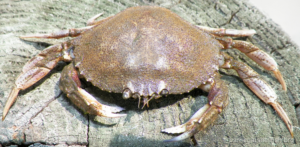 Reproduction
Reproduction
Cancer irroratus reproduction occurs in the autumn.
Sexual maturity in females is attained once they reach the carapace width size of 2.5 inches.
Males have a slightly larger 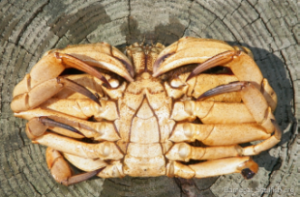 size of carapace width 2.75 inches at sexual maturity.
size of carapace width 2.75 inches at sexual maturity.
Before mating begins both male and female rock crabs molt their shell.
For males this happens during the winter months to ensure that their shells are completely firm before the fall.
Females molt their shells during the fall so that they remain soft during mating.
After fertilization females lay their eggs and store them under their stomach for almost a year.
Depending upon the female’s size the number of eggs produced can range from 125,000 to 500,000.
After a period of time the eggs hatch and between the months of June to September.
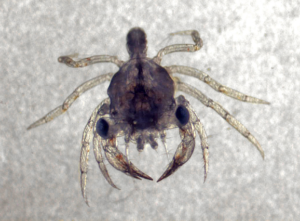 The larva stay in the water column. By the time autumn returns the larva that were hatched metamorphose into extremely small crabs called megalops.
The larva stay in the water column. By the time autumn returns the larva that were hatched metamorphose into extremely small crabs called megalops.
For the first part of their life these young crabs are extremely vulnerable to predators and water turbulence.
To increase their chance for survival they remain in shallow water and at the bottom of the ocean floor for protection.
Fun Fact – Rock crabs have the nickname “Peekytoe” … (see more)
Economic Importance for Humans: Positive
- The rock crab industry provides economic benefits
- This fishery in the Atlantic Ocean is generally new.
- Lobsters have been the most popular fishery in this region over the years.
- The rock crab fishery first began in the 1970’s but took several years to grow into an industry.
- As more markets developed for the seafood industry interest began to rise about the rock crab.
Jonah Crab Cancer borealis Walking crab
Jonah crabs are distributed in the waters of the Northwest Atlantic Ocean primarily from Newfoundland, Canada to Florida.
The life cycle of Jonah crab is poorly described and what is known is largely compiled from a patchwork of studies.
Jonah crabs are sub-par burrowers and rely on rocky cavities for shelter. Atlantic rock crabs, on the other hand, are fairly efficient burrowers in sand.
Life History
Jonah crab is a red marine crab identified by its rough edged carapace with small white to yellow spots.
Its claws have distinctively tinted black-brown tips.
It is commonly found on rocky ocean substrates in coastal New England or soft silt floors nearing the continental slope.
Snails and blue mussels are primary prey items for the Jonah crab, which uses its strong claws to crush mollusk shells.
Jonah crab are preyed on by gulls, lobster and by many fish species, such as tautog, cunner, and cod.
 Average size and age at maturity is unclear, owing to differences in growth and maturation rates throughout its geographic range.
Average size and age at maturity is unclear, owing to differences in growth and maturation rates throughout its geographic range.
It is believed male maturation occurs when the width of the carapace (CW) is around 3.5 – 4 inches across, with males larger than females.
The largest recorded crab was a male measuring almost 9 inches CW.
Female reach a maximum size of about 6 inches CW.
The smallest known egg-bearing female measured 2.6 inches CW, found on the Scotian Shelf (continental shelf southwest of Nova Scotia).
Large females can produce over one million eggs per clutch.
Jonah crab are known to migrate seasonally.
They have been observed moving into Narragansett Bay (Rhode Island) in the spring and retreating into deeper water in the winter.
Females presumably use warmer water temperatures in bays to molt and mate in the summer and early fall.
Scientists have had difficulty finding larval and juvenile Jonah crab within its known geographic range.
Some scientists suggest that Jonah crab larvae are settling elsewhere and migrating into coastal waters later.
